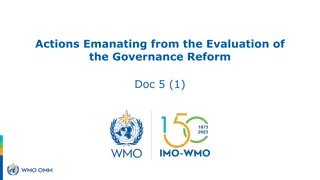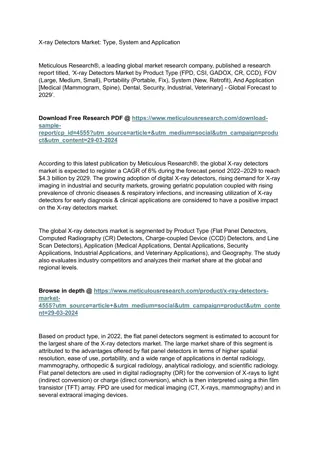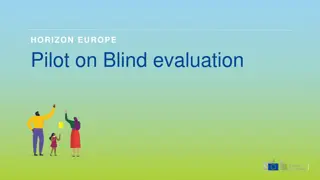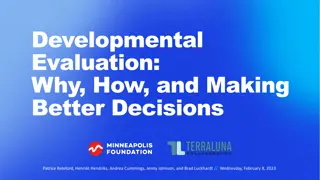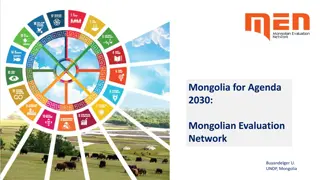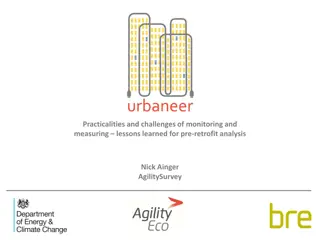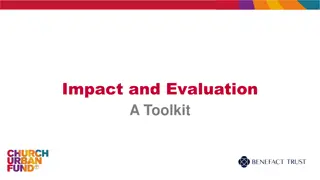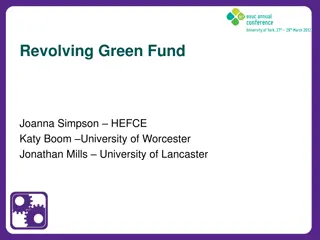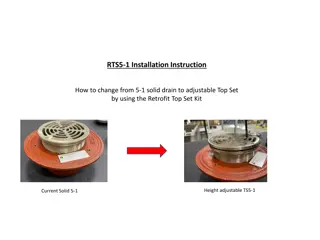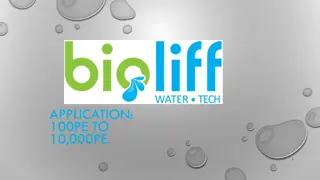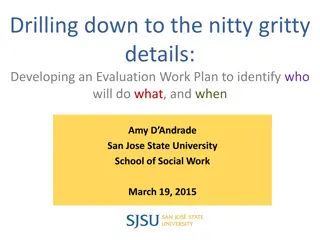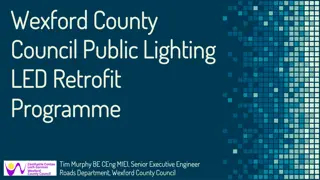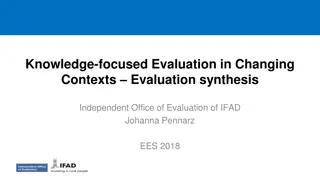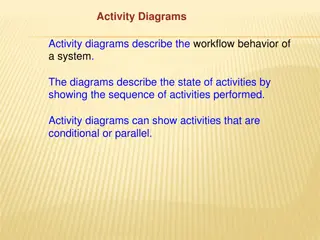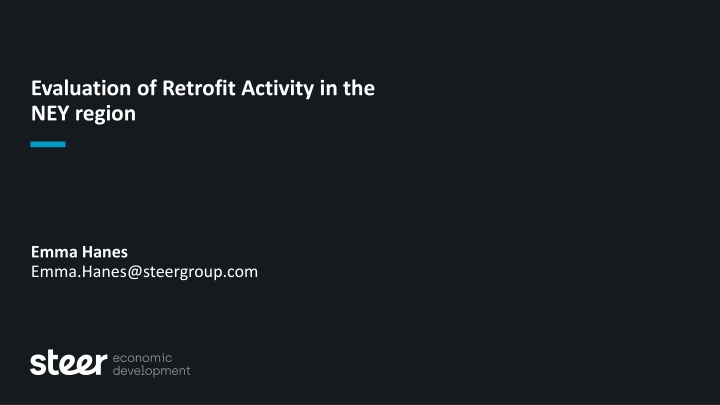
Assessment of Retrofit Activity in NEY Region - Insights & Challenges
This evaluation delves into the experiences of households, local authorities, and supply chain stakeholders in the NEY region regarding retrofit activities. Key findings highlight successes like robust relationships and challenges such as data availability and bid-writing resources. Strategies for successful beneficiary engagement include personalized approaches, trust-building, and leveraging word-of-mouth and social media. Recommendations include central government support for trust-building efforts and clear communication with beneficiaries.
Download Presentation

Please find below an Image/Link to download the presentation.
The content on the website is provided AS IS for your information and personal use only. It may not be sold, licensed, or shared on other websites without obtaining consent from the author. If you encounter any issues during the download, it is possible that the publisher has removed the file from their server.
You are allowed to download the files provided on this website for personal or commercial use, subject to the condition that they are used lawfully. All files are the property of their respective owners.
The content on the website is provided AS IS for your information and personal use only. It may not be sold, licensed, or shared on other websites without obtaining consent from the author.
E N D
Presentation Transcript
Evaluation of Retrofit Activity in the NEY region Emma Hanes Emma.Hanes@steergroup.com
The Evaluation studied the experiences of households, LAs & supply chain Evaluation key aim: understand the customer journey and lived experience of those involved, including: Homeowners and occupiers Local authorities Supply chain stakeholders. Fieldwork from 3 x stakeholder groups: 80 qual depth interviews 6 x focus groups 414 x beneficiary telephone surveys Fieldwork with beneficiaries was conducted in two waves, to capture changes in attitudes: over time with seasonality. Schemes within scope: LAD 1A, 1B, 2, 3 HUG 1 & 2 Report finalised in March 2024 26th March date 2 |
LAs raised both successes and challenges around working with partners Key challenges: Key challenges: Resourcing for bid-writing Data availability and data gaps Communication with strategic delivery stakeholders Key successes: Key successes: Use of consortia and frameworks Robust relationships between LAs and delivery partners Relationship with the Hub Some positive changes to schemes (e.g. measure mix) LAs differed in the level of sophistication they could employ to carry out data processing. Most LAs used the same partners and installers for the whole programme. LAs were pleased with the communication received from the Hub, which provided a critical friend role. Whilst some found they had sufficient data to effectively target the right beneficiaries, others found a total absence of relevant data in their area. Even when there were issues, it was felt too disruptive to break contracts mid- delivery Some issues raised with DESNZ communications delayed response times and staff turnover 26th March date 3 |
Word of mouth and building trust were important for resident engagement Most LAs used traditional media such as mail-outs and letters. These are considered easy to deploy but results in limited success as households may perceive these as spam . More hands-on methods (door- knocking; in-person events; canvassing) were considered more resource intensive, but potentially more impactful. This allows LAs to create a rapport with beneficiaries, answer questions in real-time, and quell suspicions of schemes perceived as a scam. Some LAs worked with delivery partners for beneficiary engagement. However, many found that beneficiary engagement activities generally work best when the LA is the front-facing entity. Word of mouth was considered a useful and organic way of encouraging interest, especially in communities that may be considered hard to reach otherwise. Most LAs also used social media which was considered effective and good value for money. Sharing experiences Personalised approach Building trust LAs would benefit from efforts from central government from central government to increase trust and reduce increase trust and reduce scepticism scepticism. E.g. by introducing promotional campaigns efforts Taking the time to provide beneficiaries with clear explanations explanations around why they have been chosen and why certain been chosen and why certain measures may or may not be measures may or may not be applicable applicable would enhance quality of beneficiary engagement. clear why they have Publishing success stories and allowing for online review system could help encourage a similar benefit and effectiveness of word effectiveness of word of mouth of mouth . Engagement strategies need to focus on providing reassurances about the scheme about the scheme to address beneficiary concerns around legitimacy. reassurances 26th March date 4 |
Measures to prevent household fraud were considered disproportionate LAs use multiple lines of defence to mitigate the risk of beneficiary fraud, which are more than sufficient Supplier fraud and non-compliance was raised as a larger concern Beneficiary verification methods usually include assessing documentation of the home, beneficiary income and other financial/assistance information LAs generally felt that risk-mitigation processes were in place. In several instances, non-compliant measures were uncovered down the line in post-installation checks Supplier verification methods use well-established internal processes to verify the legitimacy and capability of delivery partners LAs are getting better a vetting suppliers and installers as their expertise in increasing (e.g. some LAs were taking retrofit coordinator training) Some issues arose when the partner used their own in-house retrofit assessor marking their own homework 26th March date 5 |
Beneficiaries were pleased to receive measures, but not all understood why they had been selected Well- Beneficiaries were surprised at the value of measures they were able to receive. Beneficiaries received measures at a critical time i.e. when monthly bills were rising. informed & personable door knockers left a positive impression on beneficiaries. Positive experiences After initial contact and receiving more information about the scheme, 77% of beneficiaries felt they understood the scheme and how it would work. Beneficiaries didn t know why their property had been selected for the measures, creating confusion. Few beneficiaries had any choice about the measures that would be installed in their property, with 55% reporting they had no choice at all. Many did not receive information about the rationale for installing the measures. Beneficiary concerns Some residents experienced lengthy waiting times after being accepted into schemes. Some initial engagement methods failed to mention that they would not have to pay for measures. 26th March date 6 |
Supply chain interviewees raised a range of challenges Technical challenges: some measures (e.g. ASHP) were particularly challenging, often resulting in high drop-out rates Understanding and engagement: some beneficiaries struggle to understand technical aspects of measures, leading to misconceptions and dissatisfaction. This can lead to beneficiary dropouts. Compliance standards: due to the evolving nature of PAS2035 requirements, there is some nervousness and confusion Training and recruitment: the industry faces a strain on the availability of skilled workers Impetus for training investment: lack of continuity of retrofit programmes prevents further development of the supply chain. Private market standards: PAS2035 is not a requirement in the private market, leading some suppliers to dismiss it Aesthetic concerns: finding solutions that balance energy efficiency with aesthetic considerations remains a key challenge in retrofit projects Timescales: The delivery period of retrofit schemes is seen as unrealistic. Housing stock: lack of up-to- date data on housing stock. 26th March date 7 |
Attitude/communication of contractors is key to the household experience Interview evidence suggests the process tends to be positively reviewed when beneficiaries know what is going to happen, who is going to be in their homes, when they are arriving, how long it will take, what is involved and if the end finish looks good. Being tidy and respectful of residents homes is an important mark of quality. The interactions with staff and contractors is key. Excellent Overall beneficiary rating of installation process Very Good Neutral Poor Very Poor 0% 10% 20% 30% 40% 50% They did really well. I left them to it. They've done a good job turned up on time and tidied up after themselves Interviewee, 66+, wall and loft insulation, Bradford "They weren t tidy, punctual or reliable. I complained to Will in their office. He said it would look good when it was done, but you just have to get through it. They were a dreadful company. Survey open response 26th March date 8 |
While the measures brought benefits, aftercare was a concern Although the measures did tend to reduce beneficiaries energy bills and save them money, the savings were often lower than expected Many respondents found it hard to state how much they had saved as their energy bills had risen since the measures were installed Energy bills Despite the scheme aiming to reduce carbon emissions through the retrofitting measures, most respondents did not refer to the environmental benefits that the measures had provided unless prompted Even when prompted, the environmental benefits were largely mentioned as an afterthought Environmental benefits Product guarantees The beneficiaries who received a warranty or a product guarantee saw this as a useful addition, although most were not aware that they would receive this until it was posted or emailed to them Beneficiaries frequently stated that they felt let down by the lack of contact after the installation Beneficiaries regularly stated that the lack of a named contact for aftercare was a source of frustration, with some waiting for up to 18 months for a snag to be rectified Aftercare Beneficiaries would benefit from improved communication and support, e.g. establishing a named point of contact, being given clarity around maintenance requirements of measures, and additional information on further actions they can take to reduce carbon emissions. Customer clarity 26th March date 9 |
Thank you Please contact: Emma Hanes Associate Director Emma.Hanes@steergroup.com DISCLAIMER: DISCLAIMER: This work may only be used within the context and scope of work for which Steer was commissioned and may not be relied upon in part or whole by any third party or be used for any other purpose. Any person choosing to use any part of this work without the express and written permission of Steer shall be deemed to confirm their agreement to indemnify Steer for all loss or damage resulting therefrom.

